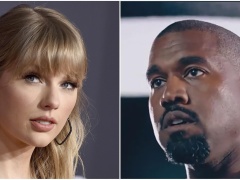
Audiences viewing Steven Spielberg’s new “West Side Story” will see many differences from the 1961 version, including a younger cast, revised screenplay and new choreography. What hasn’t changed is the music by Leonard Bernstein, the result of four high-profile experts who teamed up to record the score anew.
Oscar-nominated composer David Newman oversaw all of the arrangements and orchestrations; Tony-winning songwriter Jeanine Tesori supervised all of the vocal performances; Grammy-nominated producer Matt Sullivan was on set throughout, supervising the music during shooting; and world-renowned conductor Gustavo Dudamel conducted the Bernstein score with both the New York Philharmonic and Los Angeles Philharmonic.
The involvement of Dudamel and Newman were legendary composer John Williams’ idea. Williams, who has been Spielberg’s musical partner for 47 years, recalls Spielberg initially asking him to be music director on the film, “and I said, ‘you should get Gustavo to conduct the score. He’s done it at the Hollywood Bowl with such idiomatic flair and knowledge and swagger.'”
Dudamel also knew “West Side Story” intimately. Not only did he win raves for his semi-staged performance at the Hollywood Bowl in 2016, but his high-energy version of the score’s famous “Mambo” with the Simon Bolivar youth orchestra in his native Venezuela went viral years before he became music director of the Los Angeles Philharmonic.
Dudamel tells PvNew: “`West Side Story’ is one of the greatest American musicals of all time, and Bernstein’s score is simply iconic. As someone who loves salsa just as much as a Shostakovich symphony, I feel this music down to my bones. And to be able to work with Steven Spielberg on this was truly a dream come true.”
Williams also reminded Spielberg that David Newman “knows ‘West Side Story’ better than anybody — he’s done it all over the world,” referring to Newman having conducted the 1961 film live-to-picture nearly 50 times with orchestras in the U.S. and Europe. “David doesn’t have to study it; he knows it already,” Williams told the director. Spielberg immediately brought Dudamel and Newman on board back in 2018.
“The music of ‘West Side Story’ is timeless,” says Newman. “The ‘Symphonic Dances From West Side Story’ is in the canon of classical music. Our job was not to re-arrange, not to re-orchestrate. The music was sacrosanct. Our mandate was to present ‘West Side Story’ as Bernstein’s vision, in its best possible light.”
Newman likens this to a new staging of a classic opera. “There are lots of different opera productions like ‘Aida’ or ‘Madame Butterfly,'” Newman adds, “but it’s always the same music. I love the ’61 film, but Steven managed to make this into a movie for our day and age without being cynical.”
There are three versions of “West Side Story”: the original 1957 Broadway score, orchestrated by Sid Ramin and Irwin Kostal, played by 27 musicians; the 1961 version, conducted by Johnny Green with a 72-piece Hollywood orchestra, which Bernstein reportedly disliked; and the “Symphonic Dances From West Side Story,” Bernstein’s 23-minute condensation of themes for symphony orchestra.
“This is based more on the Broadway show,” Newman explains. Some alterations were inevitable: Newman wrote a new arrangement of “Somewhere” for Rita Moreno to sing (the Broadway version was sung by a Shark girl; in the ’61 movie, Tony and Maria sang it), and he wrote the underscore, based primarily on incidental music from the original Broadway show.
Executive music producer Sullivan (whose credits include “Chicago,” “Dreamgirls” and the live-action “Aladdin”) recalls talking with Spielberg at length “about everything from tempi to orchestration and arrangement and how he was going to shoot it… going song by song, with Steven playing the songs on his iPad, starting and stopping and talking about it.”
Of all the original authors of “West Side Story” – Bernstein, writer Arthur Laurents, choreographer Jerome Robbins and lyricist Stephen Sondheim – only Sondheim was still alive when production began in 2019. (He died Nov. 26.) “We were so lucky that he was with us, and we brought him in early,” says Sullivan.
“We called them the SS’s, SS one and SS two — Mr. Spielberg will say he was SS two. But he [Sondheim] was around all the time, came to our rehearsals, watched the choreography, listened to the actors singing the songs. There were some lyric changes [notably in “America”] and vocal assignments. Every note he gave to us was precious, and we always wanted to address all his notes.”
Bernstein was music director of the New York Philharmonic from 1958 to 1969, so that orchestra was the obvious choice for the new recording. “Some of my happiest moments on the film were sitting about eight feet behind Gustavo at the Manhattan Center, where we recorded,” Sullivan says. “He didn’t talk to the orchestra in technical musical terms – he talked about fire and spice and bringing passion to the music. This is music the New York Phil has played countless times, and I think this is the best they’ve ever played it.”
Eighty-four musicians from the New York Philharmonic, plus six Latin percussionists, played most of the score in the grand ballroom at the Manhattan Center. “Leonard Bernstein had actually used the room back in the 60’s for orchestral rehearsals,” notes Obie O’Brien, director of audio and video production at the Manhattan Center. “We couldn’t be prouder for being a part of this film.”
Dudamel calls the feeling in the room “electric. Performing this music with Bernstein’s orchestra, in the same room where he had rehearsed it, was one of the most unforgettable moments of my life. You could feel the history in every note. And to be able to record `Maria’ while my wife — who is also named Maria — listened, that was pretty special too!”
Broadway veteran Tesori (“Caroline or Change,” “Fun Home,” “Thoroughly Modern Millie”) served as supervising vocal producer. “She was in charge of all the vocals,” Sullivan explains. “Steven handed us a cast in which every single person was 95 percent there. Jeanine took them from 95 to 110 percent, and brought out these beautiful solo, duet and overall ensemble performances.”
“We pre-recorded all the vocals, but we did a lot of live singing on the set,” Sullivan points out. “The actors are always mic’d, regardless if we’re doing a playback or live singing. Therefore if there is a change in what they do, I always have a recording of what they actually did on set. The balcony scene, the duet between Tony and Maria, was all done live. Rita Moreno singing ‘Somewhere,’ that was all live. Ariana DeBose and Rachel Zegler doing ‘A Boy Like That’ and ‘I Have a Love’ live, when you watch that passion and power, belting at each other, it’s all real, all happening live on the set.”
Spielberg even found room for instrumental moments from the original score that didn’t make it into the 1961 film. Newman cites “the scene after ‘Tonight,’ where Maria’s lying on the bed, that little scherzo, a lovely piece that’s in the ballet in the original Broadway show. The Bernstein estate and I really wanted that music [in the new film], so Steven created a scene as she’s waking up and trying to make it look like she slept there. We were very happy about that.”
The New York Philharmonic recorded approximately 80 percent of the score, Newman estimates. When the COVID lockdown happened in March 2020, the recording shifted to Los Angeles, where Dudamel conducted the L.A. Phil in the remaining 20 percent or so of the music during post-production.
“I am supremely proud of this, the way it turned out,” says Newman, “the energy, the phrasing, the way it works dramatically in the film, all gorgeously played and recorded.”
“No matter where you are in time, somewhere in the world, there are always Jets and Sharks,” says Sullivan. “It’s a story that transcends generations. Steven wanted to go back to the original Broadway show and make his interpretation of this story. ‘West Side Story’ is 64 years old now, but this gives it a new breath, new life. I can’t wait for people the same age as our actors, 16 to 25 years old, to discover this music.”






